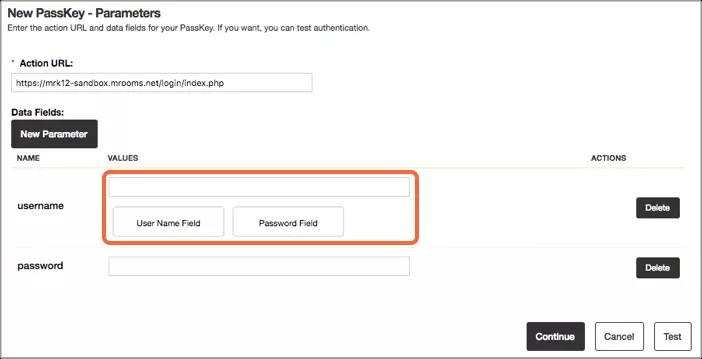You can have a collection of PassKeys that are required for the district. You can also create PassKeys suggested by registered users.
There are three types of PassKeys.
- Web Form: A one-step process that posts the login form to the web application site. It is essentially the same as users entering their login names and passwords on the login page of the web application. The difference is that the users’ login names and passwords are on forms that are submitted from Web Community Manager.
- Token: A two-step process in which the authentication request posts to the web application site. The web application site returns a web address with a token. Web Community Manager can then navigate to the site and log the user in.
- No Authentication: An authentication type for websites or web applications that do not require a log in.
Create web form authentication PassKey
Use web form authentication unless you know that it won't work for a specific web application. If you know the web application has an Application Programming Interface (API) or single sign-on (SSO), use Token authentication instead.
- From Site Manager select CONFIGURE.
- Select PassKeys.
- Select New PassKey.
- Type the PassKey Name.
- Select Web Form Authentication.
- Type the site of the web application in the Login Form URL field.
- Select Continue.
- Map parameters for the application.
- Select the Value field beside a parameter name.
- Select the correct value option that appears.
- Repeat for all parameters available.
- Select Continue.
- Optionally, provide a description, upload a logo, and determine how the application site displays.
Logos can be JPEG, JPG, GIF and PNG file types. Logos can be any size. File size affects load time.
- Select Continue.
- Select Assign Group or Assign User to assign groups or users the PassKey.
- Select Finish.
Create token authentication PassKey
Use token authentication when you know that web form authentication won't work for a specific web application or if the web application has an API or SSO.
If you use token authentication, you need to know and enter the parameters yourself.
- From Site Manager select CONFIGURE.
- Select PassKeys.
- Select New PassKey.
- Type the PassKey Name.
- Select Token Authentication.
- Select Continue.
- Type the login address of the web application in the Action URL field.
- Select New Parameter.
- Type a parameter name in the Name field.
- Select the Value field. If the correct value option doesn't appear, type the value of the parameter. For example, <YourDistrictIDHere>.
- Select Save.
- Optionally, select New Parameter to add more parameters.
- Select Continue.
- Optionally, provide a description, upload a logo, and determine how the application site displays.
Logos can be JPEG, JPG, GIF and PNG file types. Logos can be any size. File size affects load time.
- Select Continue.
- Select Assign Group or Assign User to assign groups or users the PassKey.
- Select Finish.
Create no authentication bookmark PassKey
You don't need authentication when using a PassKey as a bookmark to a web application.
- From Site Manager select CONFIGURE.
- Select PassKeys.
- Select New PassKey.
- Type the PassKey Name.
- Select No Authentication.
- Type the site address in the Website URL field.
- Select Continue.
- Optionally, provide a description, upload a logo, and determine how the application site displays.
Logos can be JPEG, JPG, GIF and PNG file types. Logos can be any size. File size affects load time.
- Select Continue.
- Select Assign Group or Assign User to assign groups or users the PassKey.
- Select Finish.
Video: Add a PassKey bookmark
The following narrated video provides a visual and auditory representation of some of the information included on this page. For a detailed description of what is portrayed in the video, open the video on YouTube, navigate to More actions, and select Open transcript.
Video: Add a PassKey bookmark explains how to add a PassKey bookmark in Web Community Manager.

